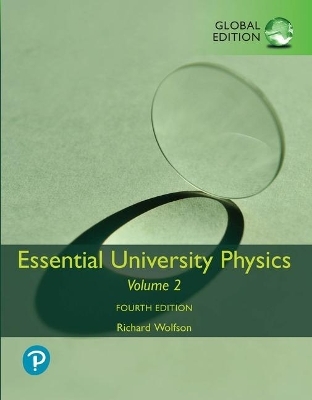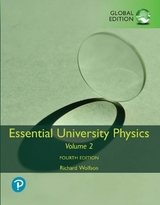
Essential University Physics: Volume 2 plus Pearson MasteringPhysics with Pearson eText, Global Edition
Pearson Education Limited
978-1-292-35119-3 (ISBN)
- Titel erscheint in neuer Auflage
- Artikel merken
Focus on the fundamentals and help students see connections between problem types
Richard Wolfson's Essential University Physics is a concise and progressive calculus-based physics textbook that offers clear writing, great problems, and relevant real-life applications in an affordable and streamlined text. The book teaches sound problem-solving strategies and emphasizes conceptual understanding, using features such as annotated figures and step-by-step problem-solving strategies. Realizing students have changed a great deal over time while the fundamentals of physics have changed very little, Wolfson makes physics relevant and alive for students by sharing the latest physics applications in a succinct and captivating style.
The 4th Edition, Global Edition, incorporates research from instructors, reviewers, and thousands of students to expand the book's problem sets and consistent problem-solving strategy. A new problem type guides students to see patterns, make connections between problems that can be solved using similar steps, and apply those steps when working problems on homework and exams. New digital tools and the interactive Pearson eText increase student interactivity to help them develop confidence in solving problems, deepen their conceptual understanding, and strengthen quantitative-reasoning skills.
Essential University Physics is offered as two paperback volumes available together or for sale individually.
Mastering Physics
Mastering (TM) is the teaching and learning platform that empowers you to reach every student. By combining trusted author content with digital tools developed to engage students and emulate the office-hour experience, Mastering personalizes learning and improves results for each student. Now providing a fully integrated experience, the eText is linked to every problem within Mastering for seamless integration between homework problems, practice problems, textbook, worked examples, and more.
Volume 1 contains Chapters 1—19
Volume 2 contains Chapters 20—39
1 Doing Physics
1.1 Realms of Physics
1.2 Measurements and Units
1.3 Working with Numbers
1.4 Strategies for Learning Physics
Part One
Mechanics
2 Motion in a Straight Line
2.1 Average Motion
2.2 Instantaneous Velocity
2.3 Acceleration
2.4 Constant Acceleration
2.5 The Acceleration of Gravity
2.6 When Acceleration Isn’t Constant
Chapter 3 Motion in Two and Three Dimensions
3.1 Vectors
3.2 Velocity and Acceleration Vectors
3.3 Relative Motion
3.4 Constant Acceleration
3.5 Projectile Motion
3.6 Uniform Circular Motion
4 Force and Motion
4.1 The Wrong Question
4.2 Newton’s First and Second Laws
4.3 Forces
4.4 The Force of Gravity
4.5 Using Newton’s Second Law
4.6 Newton’s Third Law
5 Using Newton’s Laws
5.1 Using Newton’s Second Law
5.2 Multiple Objects
5.3 Circular Motion
5.4 Friction
5.5 Drag Forces
6 Energy, Work, and Power
6.1 Energy
6.2 Work
6.3 Forces That Vary
6.4 Kinetic Energy
6.5 Power
7 Conservation of Energy
7.1 Conservative and Nonconservative Forces
7.2 Potential Energy
7.3 Conservation of Mechanical Energy
7.4 Nonconservative Forces
7.5 Conservation of Energy
7.6 Potential-Energy Curves
8 Gravity
8.1 Toward a Law of Gravity
8.2 Universal Gravitation
8.3 Orbital Motion
8.4 Gravitational Energy
8.5 The Gravitational Field
9 Systems of Particles
9.1 Center of Mass
9.2 Momentum
9.3 Kinetic Energy of a System
9.4 Collisions
9.5 Totally Inelastic Collisions
9.6 Elastic Collisions
10 Rotational Motion
10.1 Angular Velocity and Acceleration
10.2 Torque
10.3 Rotational Inertia and the Analog of Newton’s Law
10.4 Rotational Energy
10.5 Rolling Motion
11 Rotational Vectors and Angular Momentum
11.1 Angular Velocity and Acceleration Vectors
11.2 Torque and the Vector Cross Product
11.3 Angular Momentum
11.4 Conservation of Angular Mom
| Erscheint lt. Verlag | 31.10.2020 |
|---|---|
| Verlagsort | Harlow |
| Sprache | englisch |
| Themenwelt | Naturwissenschaften ► Physik / Astronomie |
| ISBN-10 | 1-292-35119-5 / 1292351195 |
| ISBN-13 | 978-1-292-35119-3 / 9781292351193 |
| Zustand | Neuware |
| Haben Sie eine Frage zum Produkt? |
aus dem Bereich



